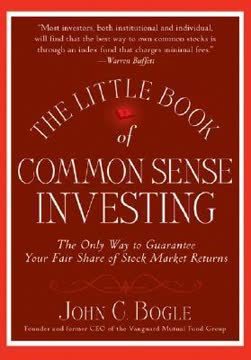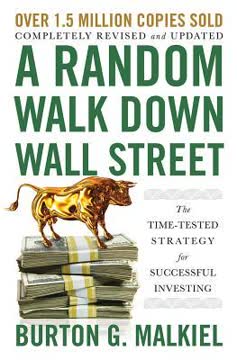Key Takeaways
1. ETFs offer low-cost, tax-efficient diversification for investors
ETFs are intelligent. Most financial experts agree that playing with individual stocks can be hazardous to one's wealth.
Low costs, high efficiency. Exchange-traded funds (ETFs) provide investors with a powerful tool to build diversified portfolios at a fraction of the cost of traditional mutual funds. With expense ratios often below 0.20%, ETFs allow investors to keep more of their returns. Their unique structure also minimizes capital gains distributions, making them highly tax-efficient for taxable accounts.
Broad market exposure. ETFs typically track indexes, offering exposure to entire markets or sectors rather than individual stocks. This instant diversification reduces the risk of any single company significantly impacting your portfolio. Popular ETFs like SPY (S&P 500) or VTI (Total U.S. Stock Market) provide access to hundreds or thousands of stocks in a single trade.
Transparency and liquidity. Unlike mutual funds, most ETFs disclose their holdings daily, allowing investors to know exactly what they own. They also trade throughout the day like stocks, providing liquidity and flexibility for investors.
2. Understand the different types of ETFs and their risk profiles
The risk-free rate of return generally refers to the return you could get on a short-term U.S. Treasury bill.
Types of ETFs:
- Stock ETFs (U.S., international, sector-specific)
- Bond ETFs (government, corporate, municipal)
- Commodity ETFs
- Real Estate Investment Trust (REIT) ETFs
- Specialized ETFs (leveraged, inverse, actively managed)
Risk spectrum. ETFs range from very low-risk (short-term Treasury ETFs) to high-risk (leveraged sector ETFs). Understanding the risk profile of each ETF is crucial for building a portfolio that matches your risk tolerance and investment goals. Generally, stock ETFs carry more risk than bond ETFs, while specialized ETFs can amplify both potential returns and losses.
Considerations for selection. When choosing ETFs, consider factors such as:
- Expense ratio
- Tracking error (how closely it follows its index)
- Trading volume and liquidity
- Underlying assets and their volatility
- Your overall portfolio allocation and risk tolerance
3. Allocate your portfolio across various asset classes and styles
Modern Portfolio Theory says that if you diversify your portfolio — putting all kinds of eggs into all kinds of baskets — you reduce risk and optimize return.
Asset allocation basics. Dividing your portfolio across different asset classes (stocks, bonds, real estate, commodities) and styles (growth, value, large-cap, small-cap) is crucial for managing risk and maximizing returns. This diversification helps smooth out portfolio performance, as different assets often perform differently in various market conditions.
The style box approach. Consider using the Morningstar style box to ensure your stock ETF holdings cover various market capitalizations (large, mid, small) and investment styles (value, blend, growth). A well-diversified portfolio might include:
- Large-cap value and growth ETFs
- Small-cap value and growth ETFs
- International developed market ETFs
- Emerging market ETFs
- Bond ETFs of varying durations
Sector considerations. While not necessary for all investors, adding sector-specific ETFs can provide additional diversification and potential for outperformance. Popular sectors include technology, healthcare, financials, and energy.
4. International ETFs provide crucial diversification benefits
You get better diversification when you diversify across borders.
Global exposure importance. International ETFs allow investors to tap into growth opportunities beyond their home country and reduce overall portfolio risk. Historically, international markets have shown lower correlation with U.S. markets, providing a cushion during domestic downturns.
Allocation suggestions:
- Developed markets: 20-30% of equity allocation
- Emerging markets: 5-15% of equity allocation
Currency considerations. International ETFs expose investors to currency fluctuations, which can enhance or detract from returns. Some ETFs offer currency-hedged versions to mitigate this risk, but they typically come with higher expense ratios.
5. Rebalance your portfolio regularly to maintain desired allocations
Rebalancing has a third purpose for you, in addition to risk-reduction and performance-juicing.
Annual rebalancing. As different assets perform differently over time, your portfolio's allocation will drift from its original targets. Rebalancing involves selling some of your winners and buying more of your underperforming assets to bring your portfolio back to its intended allocation.
Benefits of rebalancing:
- Maintains your desired risk level
- Forces a disciplined "buy low, sell high" approach
- Can potentially increase returns by up to 1.5% annually
Rebalancing process:
- Review your current allocation vs. target allocation
- Identify which assets need to be bought or sold
- Make trades, considering tax implications and transaction costs
- Consider using new contributions to rebalance when possible
6. Be cautious with specialized ETFs and active trading strategies
If you jump onto the Internet, as I just did, and type in the words "Market timing success," you will see all kinds of websites and newsletters offering you all kinds of advice (much of it having to do with reading charts) that's sure to make you rich.
Specialized ETF risks. While ETFs like leveraged or inverse funds may seem appealing, they often come with higher risks and costs. These products are designed for short-term trading and can lead to significant losses if held long-term due to daily rebalancing and compounding effects.
Avoid market timing. Despite the allure of quick profits, most investors lose money trying to time the market. Studies consistently show that even professional fund managers struggle to outperform their benchmarks over long periods. Instead of trying to predict short-term market movements, focus on building a diversified portfolio aligned with your long-term goals.
Be wary of high-turnover strategies. Frequent trading increases costs and can lead to underperformance. A buy-and-hold approach with periodic rebalancing is typically more effective for most investors. If you're tempted by active strategies, consider allocating only a small portion of your portfolio to them and closely monitor their performance and costs.
7. Patience and long-term thinking are key to successful ETF investing
The stock market is a method for transferring money from the impatient to the patient.
Time in the market beats timing the market. Historical data shows that staying invested over long periods is more likely to lead to positive returns than trying to jump in and out of the market. The S&P 500 has never had a negative return over any 20-year period, highlighting the power of patience.
Avoid emotional decision-making. Market volatility can be unsettling, but making investment decisions based on short-term fluctuations often leads to poor outcomes. Develop an investment plan based on your goals and risk tolerance, and stick to it through market ups and downs.
Dollar-cost averaging. Instead of trying to time the market, consider investing a fixed amount regularly. This strategy helps smooth out the impact of market volatility and can lead to better long-term results. Many brokers offer automatic investment plans for ETFs, making this approach easy to implement.
Last updated:
FAQ
What’s "Investing in ETFs For Dummies" by Russell Wild about?
- Comprehensive ETF Introduction: The book explains exchange-traded funds (ETFs), their structure, and how they combine features of mutual funds and stocks for individual investors.
- Practical Investing Guide: It covers ETF types, portfolio construction, risk management, and tax considerations, making it suitable for both beginners and intermediate investors.
- Wide Asset Class Coverage: Russell Wild discusses ETFs across stocks, bonds, commodities, real estate, and even active ETFs, providing a broad foundation for portfolio building.
- Accessible and Actionable: The book is designed for easy navigation, allowing readers to jump to topics of interest and apply practical advice immediately.
Why should I read "Investing in ETFs For Dummies" by Russell Wild?
- Clear, Jargon-Free Explanations: Wild breaks down complex investment concepts into simple, understandable language, making ETFs accessible to all readers.
- Fact-Based, Realistic Advice: The book avoids hype and focuses on intelligent, evidence-based strategies for long-term investing success.
- Emphasis on Cost and Tax Efficiency: Readers learn how ETFs can minimize fees and taxes, which are crucial for maximizing returns.
- Sample Portfolios and Templates: Practical examples and portfolio templates help readers tailor investments to their own goals and risk tolerance.
What are the key takeaways from "Investing in ETFs For Dummies" by Russell Wild?
- ETFs Offer Major Advantages: Low costs, tax efficiency, transparency, and diversification are central benefits of ETFs highlighted throughout the book.
- Diversification is Essential: Wild stresses the importance of spreading investments across asset classes, styles, and geographies to manage risk.
- Buy-and-Hold Outperforms Trading: A disciplined, long-term approach with regular rebalancing is favored over frequent trading or market timing.
- Practical Portfolio Construction: The book provides actionable steps for building, maintaining, and rebalancing ETF portfolios for different life stages and goals.
What are the best quotes from "Investing in ETFs For Dummies" by Russell Wild and what do they mean?
- "ETFs are the Swiss Army knives of investing." This highlights the versatility of ETFs in providing access to various asset classes and strategies.
- "Costs matter. A lot." Wild emphasizes that minimizing fees and expenses is one of the most reliable ways to improve investment returns.
- "Diversification is the only free lunch in investing." This classic investing principle is reinforced, showing that spreading risk is key to long-term success.
- "Don’t let the tax tail wag the investment dog." Wild cautions against making investment decisions solely for tax reasons, advocating for a balanced approach.
How does Russell Wild define ETFs and how do they differ from mutual funds and individual stocks?
- ETF Definition: ETFs are investment funds traded on stock exchanges, representing baskets of securities that typically track an index or market segment.
- Differences from Mutual Funds: ETFs trade intraday with fluctuating prices, usually have lower management fees, and offer greater tax efficiency due to their unique structure.
- Differences from Individual Stocks: Unlike single stocks, ETFs provide instant diversification and reduce company-specific risk, while retaining the liquidity and trading flexibility of stocks.
- Transparency and Control: ETFs disclose holdings daily, giving investors more insight and control compared to many mutual funds.
What are the main types of ETFs discussed in "Investing in ETFs For Dummies" by Russell Wild?
- Stock ETFs: Cover broad markets, sectors, styles (value, growth), and international stocks, including emerging markets, offering varying risk and return profiles.
- Bond ETFs: Include government, corporate, municipal, inflation-protected (TIPS), and international bonds, providing income and portfolio stability.
- Commodity and REIT ETFs: Offer exposure to real estate and commodities like gold, oil, and natural resources, adding diversification and inflation protection.
- Leveraged and Inverse ETFs: Use derivatives to amplify returns or bet against markets, but carry high risk and are generally not recommended for most investors.
What are the key advantages and disadvantages of ETFs according to Russell Wild?
- Advantages: ETFs offer low expense ratios, tax efficiency, daily transparency, liquidity, and easy diversification across asset classes and geographies.
- Disadvantages: Trading commissions can add up, especially for small accounts or frequent traders, and some ETFs (like leveraged or commodity ETFs) are complex and risky.
- Tax Considerations: Certain ETFs generate taxable income best held in tax-advantaged accounts, and foreign stock ETFs may offer tax credits in taxable accounts.
- Portfolio Complexity: Owning too many ETFs can complicate management and tax reporting, so simplicity is often better.
How does Russell Wild recommend building and rebalancing an ETF portfolio?
- Assess Risk Tolerance and Goals: Start by determining your risk capacity, time horizon, and financial objectives.
- Diversify Across Asset Classes: Use a mix of U.S. and international stocks (large/small cap, value/growth), bonds, and possibly REITs or commodities for broad diversification.
- Regular Rebalancing: Rebalance annually (or semi-annually for retirees) to maintain target allocations, selling winners and buying laggards to control risk.
- Portfolio Size Considerations: For small portfolios, broad ETFs or index funds may be best; larger portfolios can be split into more specific categories for better risk management.
What is Modern Portfolio Theory (MPT) and how is it applied in "Investing in ETFs For Dummies"?
- Diversification Reduces Risk: MPT shows that combining assets with low or negative correlations can lower overall portfolio volatility without sacrificing returns.
- Efficient Frontier Concept: The book explains how to find the optimal mix of assets for the highest expected return at a given risk level, using ETFs to build such portfolios.
- Limitations of MPT: Wild acknowledges that correlations can change, especially in crises, but still supports diversification as a core principle.
- Practical Application: Readers are encouraged to use MPT principles to construct and rebalance their ETF portfolios for better risk-adjusted returns.
How does Russell Wild address style investing (growth vs. value, large vs. small cap) in ETF portfolios?
- Style Grid Framework: The book divides stocks into large/small cap and growth/value categories, explaining their different risk and return profiles.
- Value vs. Growth: Value stocks often outperform over the long term but growth stocks can lead in certain periods; a balanced approach is recommended.
- Large vs. Small Cap: Small caps have historically higher returns but greater volatility; allocation should match investor risk tolerance.
- Diversification Within Styles: Wild suggests including both styles and sizes for a more resilient and diversified portfolio.
What international investing advice does Russell Wild provide in "Investing in ETFs For Dummies"?
- Global Diversification Benefits: Investing internationally reduces portfolio risk due to lower correlations with U.S. markets and enhances diversification.
- Recommended Allocation: Wild suggests allocating 40-50% of the stock portfolio to international ETFs, split among Europe, Pacific, and emerging markets.
- ETF Selection Tips: Choose broad, low-cost international ETFs, consider currency risk (hedged vs. unhedged), and be aware of foreign dividend withholding taxes.
- Balancing Developed and Emerging Markets: A mix of developed and emerging market ETFs is recommended for optimal diversification.
What common mistakes in ETF investing does Russell Wild warn about in "Investing in ETFs For Dummies"?
- Overtrading and Emotional Decisions: Frequent trading and reacting emotionally to market swings can erode returns and increase risk.
- Poor Diversification: Concentrating in one sector, style, or geography increases risk; broad diversification is essential.
- Ignoring Costs and Taxes: Not considering trading fees, expense ratios, and tax implications can significantly reduce net returns.
- Chasing Performance: Buying recent winners and selling during downturns often leads to buying high and selling low, harming long-term results.
Review Summary
Investing in ETFs For Dummies receives generally positive reviews, with readers appreciating its accessible language and humor. The book offers a comprehensive introduction to ETFs and basic investing concepts. Readers value the explanations of complex topics and long-term investment strategies. However, some note its focus on the US market as a limitation for international investors. The book is recommended for those with basic financial knowledge, providing insights on portfolio management and diversification. Some readers wished for more detailed portfolio recommendations across different demographics.
Similar Books









Download PDF
Download EPUB
.epub digital book format is ideal for reading ebooks on phones, tablets, and e-readers.





